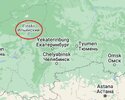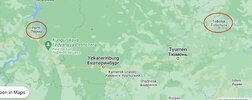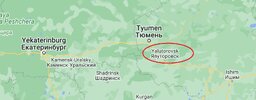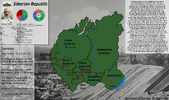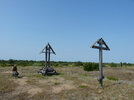Benjamin
The Living Force
...I scrolled through 100 pages of 'Iljin' in the 'Birth, marriage and death' collections. That's 5,000 entries, all in Cyrillic, having this exact name...
Just a clarification that those results for 'Iljin' had many different first names of which 'Feodor' constituted a handful by comparison.
Not knowing where else to go, I returned to the Die Furche newspaper list. With my free time-limited membership, I translated all 42 of Illion's articles using DeepL and Google (because DeepL kept booting me for 24hrs). Die Furche had already (machine) transcribed the articles so it was just a cut-n-paste job. Unfortunately, only a few of the articles are (seemingly) fully transcribed, the rest being incomplete and a few only having a paragraph or two. Nevertheless, some interesting things came out of this.
I'm not going to critique Illion's writings. I don't have the knowledge of Communist, Indian/Pakistani or Nigerian/Biafran history suitable to do so and, since the articles are incomplete, I don't know his conclusions if he made any. Rather, I'm going to focus on something a bit more general, in a way.
Illion's articles are exclusively about certain current events of his time. It becomes pretty obvious pretty quickly that he's critical of "Red China" which dominates the majority of his Die Furche articles. He seems to be well informed and keeps up with, at least, world events. But I found it interesting that he never adds anything historical. There is a mention of the 13 century Japanese Buddhist Nichiren and the Ming Dynasty but otherwise there are no references or parallels to historical events, nor are there any quotes from anybody of a historical nature. I wouldn't have been surprised to see a line from a Greek or Roman writer thrown in somewhere, or maybe a passage from the Bible, or anything from a more recent author. Unless he does so in the untranscribed parts, there is nothing at all. I started to think that he might not have a very strong knowledge base of history which made me wonder about his schooling. I'm going to guess that he went through some sort of elementary school, but after that? I could be wrong but I'm skeptical if he attended a university and that baffles me a bit because these are well written.
There is also a phrase that he uses a lot. Here are some examples:
- "Sources with good information..."
- "...the best-informed observers - including a leading French journalist these days..."
- "...the not too densely populated well-informed Asia experts wonder..."
- "...estimates by foreign experts vary widely. Japanese observers have proved to be more reliable than average in their assessment of the Red Chinese economic situation."
- "...some China experts are of the opinion..."
- " According to reports from impartial sources in areas close to China..."
- "Sources in Hong Kong, who are in regular contact with many people from Red China, claim..." [
 I mean, come on!]
I mean, come on!] - "Good experts on Asia say..."
- "According to reports from Asian sources, whose information has repeatedly proved to be accurate..."
- "According to reports from sources in a number of non-communist Asian countries (India, etc.)..."
- "...quite a few impartial experts on Asia nevertheless consider..."
- "Reliable sources claim..."
- "The prevailing impression among the well-informed is..."
- "Sources based in northern India, who despite all border controls have good connections to various inner Asian areas, report..."
- "...in the opinion of good experts on Asia, whose predictions have repeatedly proven to be valid..."
But I noticed something else. Sometimes he uses the word 'we' in a certain way and, in very rare cases, uses the words 'us' and 'our'.
Where is Nigeria Heading?- May 21, 1969
The conflicting reports from observers from both camps are difficult to bring to a common denominator. Our informants tried to compare, among other things, numerous reports of bombings of civilians.
No Weapons for Nigeria- Sept. 17, 1969
A very well-informed, impartial expert on Africa told one of our sources: “The Pope's initiative is praiseworthy. However, should hostilities not cease despite this, the fighters for peace would have no choice but to appeal directly to the goodwill of the countries that supply the belligerents with weapons.”
Turning Point in the Nigerian War?- Oct. 8, 1969
The latest report from the area of secessionists says that they are aware of the great influence of Dr. Azikiwe's focus is primarily on the common people and his assurance that no extermination campaign has been launched against "Biafra" is viewed as a serious setback for the secessionists. And we have just learned from Owerri that the leaders of the secessionists there organized an impressive funeral with African imprecation rites, at which a Dr. The doll [?] depicting Azikiwe was solemnly cursed and buried in the presence of hundreds of simple Ibos.
The Pill - A Time Bomb?- Jun. 24, 1970
Also interesting are the statements made by some leading Africans about the dangers of loud propaganda for the “pill” in view of the increasing manipulation of people in our technological age. A letter we received in this context mentions newspaper reports that an Anglican clergyman had seriously advocated the introduction of a “reproductive license” in a sermon.
Before us is an article published in a black African newspaper with the title: “Islam is against birth control”, with quotations from the Koran, which, according to the authors, prohibit artificial contraception, such as: “Do not kill the (expectant) child for fear of poverty.”
Drilling in Formosa- Apr. 21, 1971
At the same time, we learn from Saigon that soon after this news became known, no fewer than 28 oil companies from various countries expressed their interest in participating in the South Vietnamese oil business.
Hunger and Power- Nov. 24, 1971
And while a major news magazine claims in a report that impartial experts describe as one-sided that “Sheikh Muribur Rahman is facing the death penalty,” we learn from well-informed sources that heads of state and government, including President Nixon, intervened on his behalf.
Most of the Awami League leaders who fled to India reside in Calcutta. We learn from impartial informants that their prestige has been tarnished because they are accused of having failed over the course of many months to initiate a “real mass uprising”.
The Dangerous Needles- Mar. 7, 1973
Henry A. Kissinger, one of the most prominent presidential advisors and secret diplomat in the USA, analyzed and reviewed Metternich's statesmanship in his 1972 paperback history work “Great Power Diplomacy”. We can rightly recognize Kissinger as Metternich's interlocutor.
The later 'we' references are possibly just a grammatical style used to address people collectively. But the highlighted selections that I've underlined are different. Unless Illion switches to a third-person perspective while writing (like he did with his 'Canadian' admission), these selections allude to more then one person or possibly a group.
And notice here:
Where is Nigeria Heading?- May 21, 1969
Most other black African states also fear the example of such progressive “Balkanization” on any similar currents that may exist in their own countries, so that so far only four of these many countries have recognized the secession of the Nigerian Eastern Province under the name “Biafra”. This is also clear from the author of this article's correspondence with some leading African statesmen.
No Weapons for Nigeria- Sept. 17, 1969
Other African statesmen, including the head of a black African state with which the author of this article is associated, express similar fears.
Add in the humorous 'letter to the editor' complaint Illion sent to the Salzburg Nachrichten paper where he reveals his correspondence with a person in Vienna and you get the impression that he is a connected guy with a seemingly well established information network that appears to, at least, extend to Japan, India and Nigeria. Additionally, reading many newspapers from around the world, whatever he hears on the radio and his personal experiences from travelling to 15/16 countries and Illion becomes quite the man in the know, at least on certain topics. Then there's this:
The Spectre of China- July 30, 1969
At a meeting of Western and Eastern European politicians, diplomats, university professors and freelance journalists in Grundlsee, which was not hindered by the Soviet side, the aim was openly to achieve closer cooperation between Western and Eastern European states, independent of ideologies. At this meeting, which received little public attention and to which the author of this article was invited, an official representative of Romania also confirmed the position of his and “other socialist countries” that “the division of the world into military blocs is an anachronism and an obstacle on the way to state cooperation”.
This admission implies that Illion travels in some pretty elite company. Remember the admission that he was a member of the Club of Rome? This isn't proof but is this support for it? I don't think so.
The first full meeting of the Club of Rome was at the Accademia dei Lincei in Rome, Italy in 1968. It was considered a "monumental flop". The second full meeting was sponsored by Pierre Trudeau and the Canadian Government and held in April, 1971 at the Seigniory Club in Chateau Montebello (which is for sale, btw), Quebec. At this meeting, "members heard the outline of a global “Systems Dynamics” model that would become the basis for The Limits to Growth", which was published in 1972. The Club of Rome was not a big deal in 1969, so to have a meeting of such significant participants as described by "the author of this article" (a phrase he uses seven times throughout the articles) is unlikely Club of Rome members.
Now, this meeting may have happened. However, I could find three articles in the SN about the The Fifth World Congress of the Theosophical Society (mentioned earlier) in Salzburg, but I couldn't find a reference to this gathering in Grundlsee on Grundlsee Lake in the SN or Die Furche. And this is what bothers me: "At this meeting, which received little public attention..." is reported by Illion. I'm leaving it open, but I wonder if he's controlling the narrative.
I took a look at Illion's biography again (found in the Darkness Over Illion article) where he mentions:
As a child he ran away from home and lived roughly like Kipling's "Kim" (by the way, the applicant knew "Kim", whose real name was Hastings Palmer, quite well).
Hastings Palmer? Yeah right. But I wonder if Illion got some inspiration from that book?
It's interesting that, throughout his biography, he refers to himself in the third-person exclusively. Unlike his books In Secret Tibet and Darkness Over Tibet where he uses 'I' and 'my', Illion doesn't us 'I' in his newspaper articles or biography (he does use 'my' once in the first article Dangerous Vacuum). He has 'plurals' and 'third-persons'. Is he dissociating? (see: The Myth of Sanity)
On a sidenote he also mentioned:
...stayed several times at the house of Vidunas, the Lithuanian national poet...
Looking at his wikipage, I find that Vydūnas was a pioneer of pagan revival and one of the leaders of the theosophical movement in East Prussia.
Attachments
Last edited:


